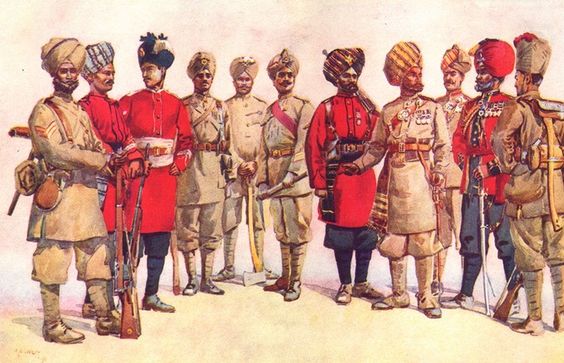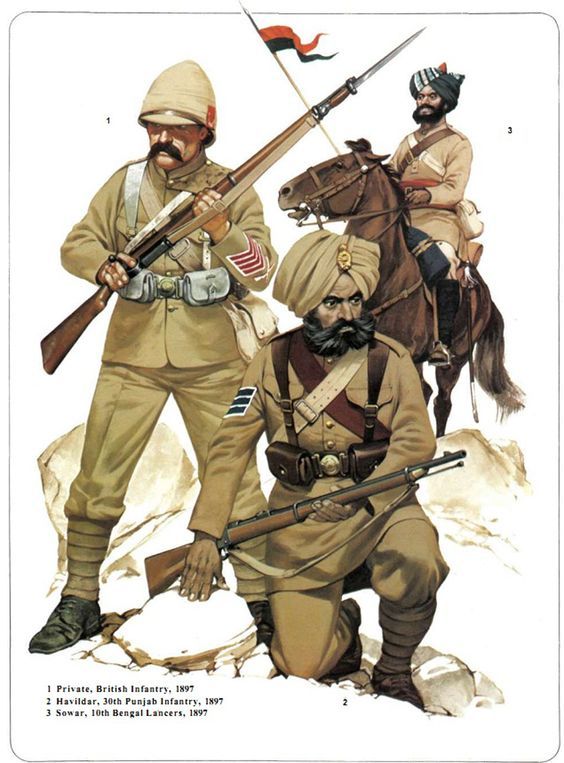
This essay will seek to show the trends of organization, regionalized recruitment policy, and institutional unification of the British Indian Army and how these trends were reproduced by the Pakistan Army after 1947.
Syed Hussain Shaheed Soherwordi
School of History & Classics, University of Edinburgh
The Advent of the British Indian Army
Major Stringer Lawrence, who formed the first military units of the East India Company in Madras in 1748, is regarded as ‘the father of the Indian Army’.
He organized the British Indian army that was divided into three presidencies: Bengal, Madras and Bombay. The three presidencies formed their own armies which later on constituted the Indian Army: the Bengal Army (eventually developed into the largest army); the Madras Army (a combination of companies of doorkeepers and watchmen); and the Bombay Army (that arrived as a detachment when Bombay passed to the British as part of the dowry that Catherine of Braganza brought to her marriage to Charles II).
The first British regulars, the 39th Foot, arrived in India in 1754 under the command of Colonel John Adlercron. He began the amalgamation of the East India Company’s Indian Army (European and Indian troops) and Royal British regulars (rented from the Crown and constituted the British Army) in India.
Until this time all – British and Indian, Company and Royal troops – were officered by Britons. The armies based in Madras, Bombay and Bengal functioned as three distinct entities. Training, discipline and professionalism were the primary requirements for Indian soldiers. Intensive training with an emphasis on discipline and efficiency and their separation from the fragmented Indian society turned the Indian soldiers into a professional, united and autonomous fighting force. Their loyalty was to their ‘homogeneous military units’ for which they served ‘full time, long term’ rewarded with a secure pay and pension system.
At the end of the eighteenth century, the Company started sending troops on overseas voyages. Due to the reluctance of the Hindu soldiers to serve overseas, the troops were given options for such expeditions on a voluntary basis. In 1846 and 1849, two important frontier forces, the Sindh Frontier Force (SFF) and the Punjab Frontier Force (PFF), were created. The SFF was to deal with the Baluch tribesmen and was part of the Bombay Army. The PFF was raised for keeping order on the North Western border. It was to serve on the frontier and only in special cases elsewhere. Later on, the Gurkha Regiment was also added to the PFF. The Frontier Force was under the control of the Foreign Department of the Government of India through the Lieutenant Governor of the Punjab. In 1886, this was brought under the operational control of the C-in-C, India, as part of the Bengal Army. It continued to maintain its separate character until 1903, when it was incorporated into the Indian Army.
The East India Company administered India until 1858, through three Presidencies each with its own army. These armies consisted of British and Indian to exercise supervisory control over them. Prior to 1886, he had no authority over the Punjab Irregular (later Frontier) Field Force – known as the ‘Piffers’ – on the North West Frontier, which was controlled by the Lieutenant-Governor of the Punjab. Also, of course, he had no direct control over the armies of the Princely states. In fact, no officer exercised control over all of the Indian land forces.

From the second half of the eighteenth century, the Bengal Army recruited from the communities that had served the Muslim dynasty in the past. Recruitment focused on high caste Hindus, mainly from Bihar, Oudh and Agra. The Gurkhas and the Punjabis were also recruited. It was a high-caste ethnic army. The Madras Army concentrated for recruitment on Madras, Hyderabad, and the Central Provinces, and later, Burma while the Bombay Army’s focus was on Bombay, Sindh, Rajputana and Aden. Unlike the Bengal Army, both of these armies’ recruitment was supra-caste and supra-religion. With the British Government taking over the reins of the East India Company, the shape of all the three armies was completely changed. In August 1858, the British Government introduced a major shift in their organizational setups. For such drastic changes, the Peel Commission (1859) and the Eden Commission (1879) played a major role. The Commission reports stressed the need to maintain a disciplined, regiments commanded by British officers. The Bengal Army (being the largest) had a distinct position as its C-in-C was also the head of the Company’s other armies. His powers were very nominal over the armies of Madras and Bombay. He was supposed professional and loyal trained army. All three armies were retained, but the position of the C-in-C was braced with more powers. The strength of the British troops was raised to 80,000; of which 50,000 were for Bengal, 15,000 for Madras, and 15,000 for Bombay. They were also given total control over artillery and some other branches of the Army.
Additionally, according to the Peel Commission, Native forces were not to bear a greater proportion to the European, in Cavalry and Infantry, than two to one for Bengal, and three to one for Madras and Bombay respectively. All such developments were the after-effects of the Mutiny War of 1857. The homogenous nature of the Bengal army was one of the factors that contributed to the outbreak of the Mutiny. Hence, in future, the British maintained distinction and separateness of castes and class in the army. No single caste or class was allowed to dominate or command another caste or class. To avoid unity amongst native soldiers, the Peel Commission Report recommended that ‘the Native Army’ should be composed of different nationalities and castes, and as a general rule, mixed promiscuously through each regiment’. However, local regiments were also limited to their respective areas of recruitment except in case of emergency.
The separation of the three armies in India was usually debated by the British Administration at different points. The Eden commission recommended the ‘endeavor … to carry out the principles of segregation’. However, it was in the year 1895 that all the three armies were amalgamated to create the Indian Army, headed by a C-in-C. Under the C-in-C there were four commands: the Madras Command, the Bombay Command, the Bengal Command and the Punjab Command, each headed by a Lt. General. The former Bengal Army was split into Bengal and Punjab Commands. The title of Indian Army began to be used officially from 1 January 1903. In 1911, George MacMunn recalls the Indian Army as one which became one of the marvels of modern times, and for which the people of the subcontinent used to say:
Khalk-i-Khuda
Mulk-i-Sirkar
Hukm-i-Sahiban Alishan.
(Continues)
___________________
Courtesy: Centre for South Asian Studies, School of Social & Political Science, University of Edinburgh, Scotland, UK.